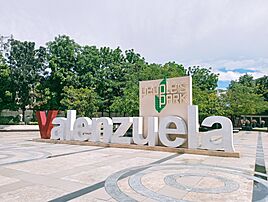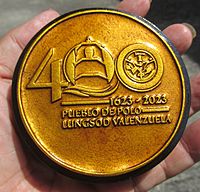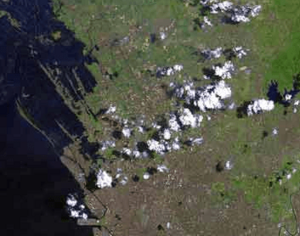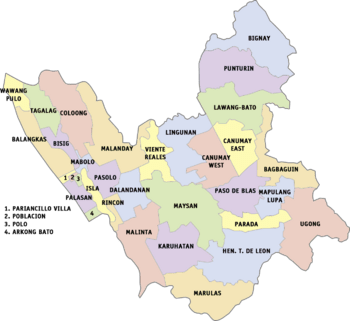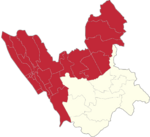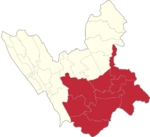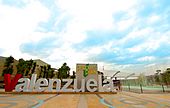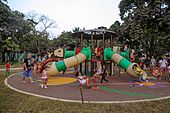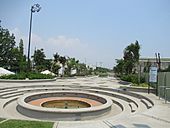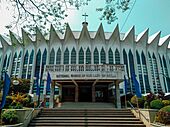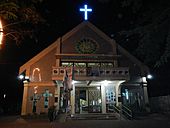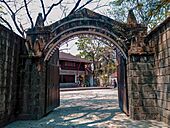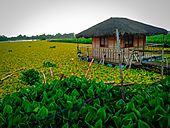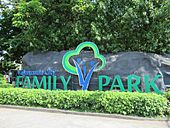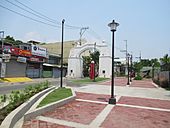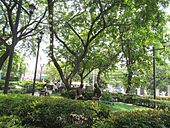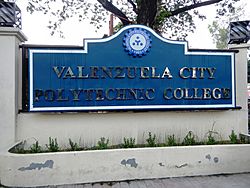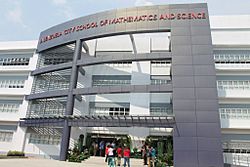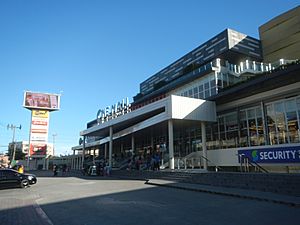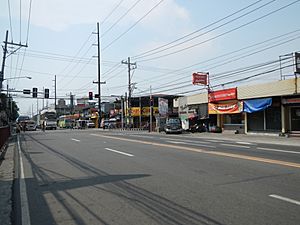Valenzuela, Metro Manila facts for kids
Quick facts for kids
Valenzuela
|
|||
|---|---|---|---|
|
Highly urbanized city
|
|||
|
Dr. Pio Valenzuela Museum
Arkong Bato
Valenzuela People's Park
San Diego de Alcala Parish Church
National Shrine of Our Lady of Fatima
|
|||
|
|||
| Motto(s):
"Tayo na, Valenzuela!"
"Valenzuela, May Disiplina" |
|||
| Anthem: Himig Valenzuela Valenzuela Hymn |
|||

Map of Metro Manila with Valenzuela highlighted
|
|||
|
OpenStreetMap
|
|||
| Country | Philippines | ||
| Region | National Capital Region | ||
| Province | none | ||
| District | [[{{#property:P7938}} | — Lua error in Module:Wd at line 1804: attempt to index field 'wikibase' (a nil value).]] | ||
| Founded | November 12, 1623 | ||
| Cityhood and HUC | December 30, 1998 | ||
| Founded by | Juan Taranco and Juan Monsód | ||
| Named for | Pío Valenzuela | ||
| Barangays | 33 (see Barangays) | ||
| Government
|
|||
| • Type | Sangguniang Panlungsod | ||
| Area | |||
| • Total | 47.02 km2 (18.15 sq mi) | ||
| Area rank | 119th of 145 cities | ||
| Elevation | 22 m (72 ft) | ||
| Highest elevation | 109 m (358 ft) | ||
| Lowest elevation | -5 m (−16.4 ft) | ||
| Population
(2024 census)
|
|||
| • Total | 725,173 | ||
| • Rank | 11th of 145 cities | ||
| • Density | 15,422.6/km2 (39,944/sq mi) | ||
| • Households | 193,025 | ||
| Demonym(s) | Valenzuelaño Valenzuelano Valenzuelaña Valenzuelana |
||
| Economy | |||
| • Income class | 1st city income class | ||
| • Poverty incidence |
|
||
| • Revenue | ₱ 6,109 million (2022) | ||
| • Assets | ₱ 12,885 million (2022) | ||
| • Expenditure | ₱ 5,409 million (2022) | ||
| • Liabilities | ₱ 5,175 million (2022) | ||
| Service provider | |||
| • Electricity | Manila Electric Company (Meralco) | ||
| Time zone | UTC+8 (PST) | ||
| PSGC |
[https://psa.gov.ph/classification/psgc/?q=psgc/barangays/{{#pro000®code={{&provcode=
|
||
| IDD : area code | +63 (0)02 | ||
| Native languages | Tagalog | ||
| Website | valenzuela |
||
Valenzuela is a busy and important city in the National Capital Region of the Philippines. It is known as a highly urbanized city, which means it is a big city with many people and businesses. As of the 2020 census, about 714,978 people live here.
Valenzuela is the 6th most populated city in Metro Manila and the 11th most populated in the entire Philippines. It is located about 14 kilometers north of Manila, the country's capital. The city is bordered by the province of Bulacan and the cities of Caloocan, Malabon, and Quezon City. It also shares a border with Malabon along the Tenejeros-Tullahan River. The city covers an area of about 45.75 square kilometers. Most residents are Tagalog people, with a smaller number of Bicolanos and people from other countries.
The city was first called Polo and was formed in 1621. In 1960, part of Polo was separated and named Valenzuela after Pío Valenzuela, a doctor and a member of the Katipunan, a group that fought against Spanish rule. The two parts later rejoined and kept the name Valenzuela. The city's current boundaries were officially set in 1998.
Contents
- What's in a Name?
- A Look Back: Valenzuela's History
- Valenzuela's Location and Environment
- City Government
- People of Valenzuela
- Culture and Celebrations
- Economy
- Fun Places to Visit in Valenzuela
- City Services
- Getting Around Valenzuela
- International and Local Friends
- Famous People from Valenzuela
- See also
What's in a Name?
In Spanish, Valenzuela means "little Valencia." The city was named after Pío Valenzuela y Alejandrino, a Filipino doctor and hero. He was a key leader of the Katipunan, a secret society that started the Philippine Revolution against Spain in 1896.
Before 1960, the city was known as Polo, which is where Pío Valenzuela was born. The name Polo comes from the Tagalog word pulô, meaning "island" or "islet." Even though the area wasn't a real island, it was surrounded by rivers, making it feel like one.
A Look Back: Valenzuela's History
Early Days Under Spanish Rule
During the Spanish era, the area that is now Valenzuela was part of Bulacan province. It was known as Polo and included several large estates called haciendas.
In 1595, the church leaders in Meycauayan decided that Polo should have its own church. This was because more people were moving there. Thanks to the efforts of a friar named Juan Taranco and a local leader named Don Juan Monsód, Polo became a separate town on November 7, 1621. Its new patron saint was St. Didacus of Alcalá. The separation was officially confirmed by the Governor-General on November 12, 1623. This date is now celebrated as the city's foundation day.
The Polo Church
Construction of the San Diego de Alcalá Church began in 1627. The first church building was finished in 1632. Over the years, it was repaired and changed. Sadly, a strong earthquake in 1865 damaged its bell tower. The main church building was later destroyed during World War II.
Changes in Town Borders
In 1753, a new town called Obando was created from part of Polo. It was named after the Governor-General at the time.
Later, in 1856, another area called Novaliches was formed. This new town included parts of Polo, like the Hacienda Tala, which was originally a penal colony where prisoners worked on land.
The Fight for Freedom
In 1869, Pío Valenzuela, a Filipino doctor and patriot, was born in Polo. He joined the Katipunan in 1892, a secret society fighting for Philippine independence. He became a key leader and helped print Ang Kalayaan, the Katipunan's newspaper.
When the Philippine Revolution began in 1896, Polo joined the fight. Many residents were killed by the Spanish during this time.
After the Spanish–American War, the Americans took control of the Philippines. Pío Valenzuela was appointed as the first municipal president of Polo in 1899. During the Philippine–American War, Polo saw heavy fighting.
In 1910, a stone arch called Arkong Bato was built. It marked the boundary between Polo and Malabon. This arch is still a famous landmark today.
World War II and Beyond
During Second World War, the Japanese occupied Polo. The old San Diego de Alcalá church was used as a place for questioning. On December 10, 1944, many men from Polo and Obando were killed. The town was partly burned during the liberation by Filipino and American forces. The historic bridge connecting the northern and southern parts of Polo was destroyed by the Japanese to slow down the Allied troops. After the war, the northern part was freed first, followed by the southern part on February 11, 1945.
In 1960, Polo was divided into two towns: Polo and Valenzuela. However, this split caused problems, so in 1963, the two towns were reunited and officially named Valenzuela.
Becoming a City
On November 7, 1975, Valenzuela became part of Metro Manila. This was a big change, as it was no longer part of Bulacan province.
On February 14, 1998, Valenzuela officially became a highly urbanized chartered city. This meant it gained more independence and power to manage itself. Valenzuela was the 12th city to join Metro Manila.
Valenzuela's Location and Environment
Valenzuela is located about 14 kilometers north of Manila. Manila Bay, an important port, is about 16.3 kilometers west of the city. Valenzuela is surrounded by other cities and towns.
The highest point in Valenzuela is 38 meters above sea level, found in the Canumay industrial area. Most of the city is much lower, averaging only 2 meters above sea level. This means some areas are close to water levels and can be affected by floods.
The Tenejeros-Tullahan River, also called Tullahan River, separates Valenzuela from Malabon. This river was once full of shellfish and fish, but it has become very polluted. Efforts are being made to clean it up.
Because of its location, Valenzuela experiences a tropical monsoon and tropical savanna climate. This means it has two main seasons: a dry season and a wet season. Humidity is often high, making hot days feel even hotter. Heavy rainfall can sometimes lead to stagnant water and increase the risk of water-borne diseases.
City Divisions: Barangays and Districts
Valenzuela has 33 small administrative units called barangays. Each barangay has a leader called a punong barangay and a council of 7 members. There is also a youth council called the Sangguniang Kabataan (SK) with its own chairperson and 7 members. These officials are elected by the residents.
The city is also divided into two congressional districts for national representation. The first district has 24 barangays, and the second district has 9. These districts elect representatives to the House of Representatives of the Philippines.
City Government
Like other cities in the Philippines, Valenzuela is led by a mayor and a vice mayor. They are elected for three-year terms. The mayor is in charge of running the city and making sure public services are provided. The vice mayor leads the city council, which has 14 members. These councilors create the city's rules and policies.
The current mayor is Weslie T. Gatchalian, and the vice mayor is Marlon Paulo D. Alejandrino.
City Police and Courts
Valenzuela has its own police station, the Valenzuela City Police Station (VCPS). It is part of the Northern Police District. There are over 500 police officers in the city.
The city also has several courts that handle legal cases. The Valenzuela City Jail works with the local government and the Department of Education to offer educational programs for inmates.
People of Valenzuela
People from Valenzuela are called Valenzuelano (for males) or Valenzuelana (for females).
In 2020, Valenzuela had a population of 714,978. This makes it the 7th most populated city in Metro Manila. The population has grown by 7.8% since 2010.
The five barangays with the most people are Gen. T. de Leon, Marulas, Malinta, Ugong, and Karuhatan. In 2010, about half of the population was male and half was female. Most residents (66.7%) are in the working-age group (15 to 64 years old).
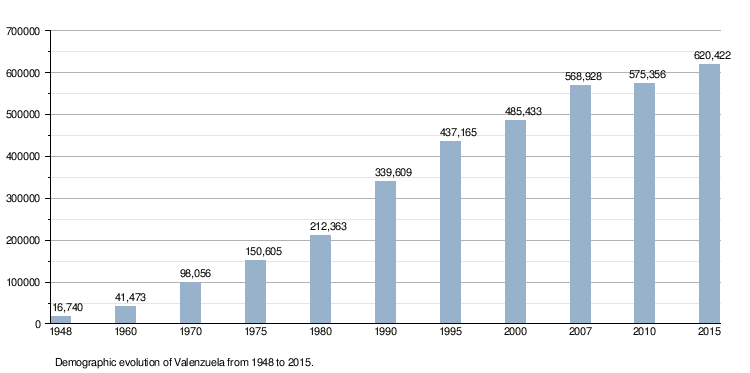
Culture and Celebrations
City Anthem: "Himig Valenzuela"
"Himig Valenzuela" is the official song of the city. It is sung during flag ceremonies in schools and government offices. The song was created to encourage unity and patriotism among the city's residents. A city rule requires everyone to sing the hymn at public events.
Feasts and Holidays
Valenzuela celebrates its cityhood every February 14. This day is a special non-working holiday. The city's foundation day is celebrated on November 12 each year, remembering when Polo was established in 1623.
Each barangay in Valenzuela also has its own feast day. Many celebrations happen in May and April to honor patron saints.
- The santacruzan is a procession held every April 26 in Barangay Isla. It remembers St. Helena's search for the cross.
- The Mano Po, San Roque Festival is celebrated every May 12 in Mabolo. People dance and pray to San Roque, who is also known as the patron saint of unmarried people. This festival also remembers the town's victory after the British left in 1763.
- The Feast of San Diego de Alcala is celebrated every November 12 in Poblacion. This event honors the oldest church in Valenzuela. It includes boat races, street dancing, and the famous putong Polo festival. Putong Polo is a special rice cake from the area.
Economy
Valenzuela has grown from a farming area into a major center for business and industry in the Philippines. Many industries have moved to the city.
Fun Places to Visit in Valenzuela
- The Valenzuela City People's Park is a large park next to the city hall. It has a dancing fountain, playgrounds, and an amphitheater for events.
- The Valenzuela City Family Park is another public park that brings nature into the city. It features a playground, an interactive fountain, an aviary, and outdoor fitness equipment. It's also friendly for pets and bikes.
- The Polo Mini Park was opened in 2020. It has old trees, a fountain, and statues of heroes like Pío Valenzuela and José Rizal. It's a place for relaxation and remembers the city's history.
- Arkong Bato means "arch of stone." This arch was built by Americans in 1910 to mark the border between provinces. Today, it marks the boundary between Valenzuela and Malabon.
- The Harry C. Egbert Memorial is a monument in Malinta. It remembers Brigadier General Harry Clay Egbert, an American officer who was injured here in 1899 during the Philippine–American War.
- The Museo Valenzuela (Valenzuela Museum) is located where Dr. Pío Valenzuela was born. It shows artifacts and stories about the city's past.
- The Libingan ng mga Hapon (Japanese Cemetery) is a burial ground for Japanese soldiers who died during World War II.
- The National Shrine of Our Lady of Fatima is an important religious site. It houses a wooden statue of Our Lady of Fatima. This statue was part of a special event blessed by Pope Paul VI in 1967.
- The Residence of Pío Valenzuela is where Dr. Pío Valenzuela lived and died. This house was a secret meeting place for the Katipunan.
- The San Diego de Alcala Church and its bell tower were built in 1632. Only the bell tower and entrance arch remain today, as the main church was destroyed during World War II.
- The Hearts of Jesus and Mary Parish Church in Malanday was built in 1994.
- The Valenzuela Astrodome is a large indoor stadium in Dalandanan. It hosts sports events, concerts, and other activities.
- The Tagalag Fishing Village is a unique spot with a 1.3-kilometer boardwalk. You can enjoy fishing, bird watching, boating, and watching the sunset here.
- The Valenzuela boardwalk is a walkway with a bike trail along a flood dike. It connects several barangays and was opened in 2024.
- Gallery of tourist spots in Valenzuela
-
Polo Park.jpg
Polo Mini Park
City Services
Education in Valenzuela
Valenzuela City works hard to provide good education for its citizens through the "WIN ang Edukasyon Program." This program helps fund computer labs in schools. It also provides free workbooks for elementary students. The city government also repairs and builds new classrooms.
The city has its own university, Pamantasan ng Lungsod ng Valenzuela (PLV), and a technical school, Valenzuela City Polytechnic College (VCPC). These schools offer higher education to residents. There are also private schools like the Our Lady of Fatima University (OLFU).
Healthcare Services
Valenzuela has several hospitals, including the city-run Valenzuela City Emergency Hospital and Valenzuela Medical Center. There are also private hospitals like Fatima University Medical Center. The city has a "VC Cares Program" to help residents with healthcare needs.
Because of some swampy areas and the Tullahan River, there can be mosquitoes. This means residents need to be careful about mosquito-linked diseases like dengue. The Department of Health has given out special anti-dengue nets to schools to help prevent the spread of these diseases.
Shopping and Utilities
Valenzuela has shopping centers like SM City Valenzuela and Puregold Valenzuela. These stores offer a variety of products.
Water supply for the city comes from Maynilad Water Services, Inc. In 2010, a school in Ugong became the first in the Philippines to use solar generators for electricity. This was part of the city's effort to use clean energy.
Waste Management
Valenzuela is known for its recycling efforts. The city has many recycling companies, especially for plastic materials. The city government works to manage waste and convert biodegradable waste into fertilizers. In 1988, the city opened its first waste disposal facility, the Lingunan Controlled Dumpsite. This dumpsite was later turned into a sanitary landfill.
Getting Around Valenzuela

Major roads like the North Luzon Expressway (NLEX) and NLEX Harbor Link pass through Valenzuela. You can access NLEX from the Paso de Blas Interchange. The Harbor Link project also provides access to different parts of the city.
Valenzuela is connected to Bulacan province by MacArthur Highway. The Tullahan Bridge connects Valenzuela to Malabon.
The city has many roads, mostly made of concrete. The Valenzuela Gateway Complex Terminal is a main bus terminal for buses traveling north. Other ways to get around include jeepneys, tricycles, and taxicabs.
International and Local Friends
Valenzuela has "sister city" relationships with other cities and towns. These partnerships help with cultural and academic exchanges.
- Bucheon, South Korea (since 2006)
- Many cities and towns in the Philippines, including Santa Cruz, Marinduque, Narvacan, Angeles, and Navotas.
Valenzuela also has informal friendship links with Yangzhou, Jiangsu in China and [[Kauaʻi, Hawaii]] in the United States.
Famous People from Valenzuela
- Virgilio "Billy" Abarrientos, a famous basketball player.
- Bobbit Carlos, a former mayor and representative.
- Danilo Concepcion, a former university president and law dean.
- Glaiza de Castro, a Filipina actress and singer.
- Ford Valencia, a singer and member of Boyband PH.
- Gerard "Gerry" Esplana, a former athlete and city councilor.
- Rex Gatchalian, a former mayor and current Secretary of Social Welfare and Development.
- Win Gatchalian, a former mayor and current Senator of the Philippines.
- Charee Pineda, an actress and city councilor.
- Randy Santiago, an actor, host, and singer.
- Raymart Santiago, an action star and comedian.
- Shalani Soledad, a former city councilor and TV personality.
- Pío Valenzuela, the city's namesake, a doctor and patriot.
See also
 In Spanish: Valenzuela (Gran Manila) para niños
In Spanish: Valenzuela (Gran Manila) para niños
- Geography of Manila
- List of populated places in Metro Manila
- List of renamed cities and municipalities in the Philippines
- Public transport in Manila
- Transportation in Metro Manila




